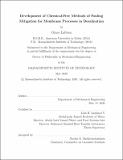Development of chemical-free methods of fouling mitigation for membrane processes in desalination
Author(s)
Labban, Omar.
Download1191716330-MIT.pdf (17.60Mb)
Other Contributors
Massachusetts Institute of Technology. Department of Mechanical Engineering.
Advisor
.John H. Lienhard V
Terms of use
Metadata
Show full item recordAbstract
As water scarcity continues to intensify around the globe, the need for more efficient and sustainable desalination technologies has never been more pressing. While membrane technology, namely reverse osmosis (RO), currently stands as the most energy efficient desalination technology, it is plagued by fouling undercutting both productivity and permeate quality. To restore performance, desalination plants resort to chemical cleaning, incurring losses in productivity, chemical cost, and membrane replacement all while raising environmental concerns associated with chemical waste. In this work, we explore alternative chemical-free methods of membrane fouling mitigation. First, membrane pretreatment using nanofiltration is investigated as a means of mitigating inorganic fouling in downstream desalination systems. Transport modeling is employed in fabricating specialized nanofiltration membranes for desalination pretreatment. The Donnan-Steric Pore Model with dielectric exclusion (DSPM-DE) is used to probe for desirable membrane properties, while new membranes are systematically fabricated in-house using layer-by-layer (LbL) deposition to validate model predictions and to develop a new specialized membrane for this application. The new membrane presents a 30% increase in permeability and a 50% reduction in permeate hardness relative to state-of-the-art NF membranes. Apart from proactive pretreatment approaches, reactive approaches remain necessary in handling already fouled RO membranes. To that end, osmotically-induced cleaning (OIC), whereby a RO membrane effectively undergoes osmotic backwashing, is explored. Specifically, the effectiveness of OIC against organic fouling is examined, underlying mechanisms are elucidated, and potential applicability in the presence of spacers is investigated. While experimental results demonstrate flux recoveries of up to 30%, the method's effectiveness is shown to be dramatically influenced in the presence of spacers and far from completely eliminating a biofilm or preventing its regrowth once operation is resumed. Given the practical limitations of OIC, we finally present the development of deformation-induced cleaning (DIC), a novel chemical-free fouling mitigation method. applicable to commercially existing spiral-wound membrane modules. The method employs controlled membrane deformation through pressure modulation, which induces shear stresses at the foulant-membrane interface that lead to detachment and removal of the foulants. Experiments on organic fouling by alginate are conducted on a flat-sheet membrane coupon followed by tests on a commercial spiral-wound module. Shutdown durations are shown to be six-fold lower, while flux recoveries are comparable to those of chemical methods. In-situ visualization is employed alongside bench-scale experiments to elucidate the underlying mechanisms and ultimately devise an optimized chemical-free fouling mitigation strategy. Experiments on a commercial spiral-wound module indicate this method will have applicability in industrially-relevant settings. By enabling more frequent cleanings, DIC considerably lowers operating expenses while offering a more sustainable and environmentally sound solution to membrane fouling mitigation in desalination.
Description
Thesis: Ph. D., Massachusetts Institute of Technology, Department of Mechanical Engineering, May, 2020 Cataloged from the official PDF of thesis. Includes bibliographical references (pages 145-157).
Date issued
2020Department
Massachusetts Institute of Technology. Department of Mechanical EngineeringPublisher
Massachusetts Institute of Technology
Keywords
Mechanical Engineering.